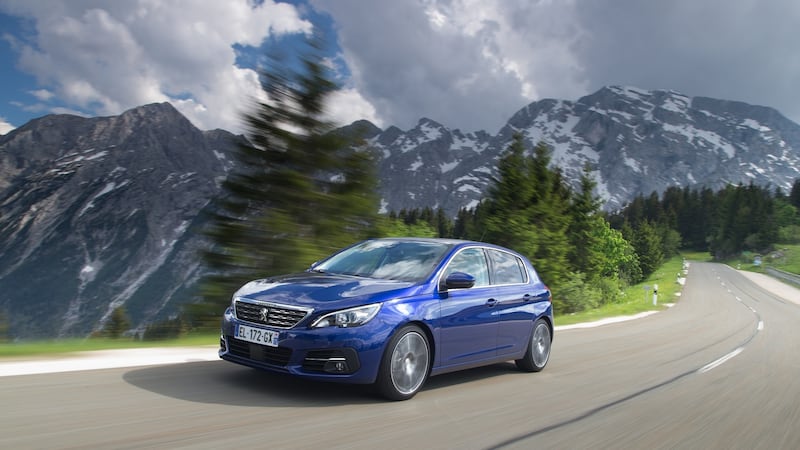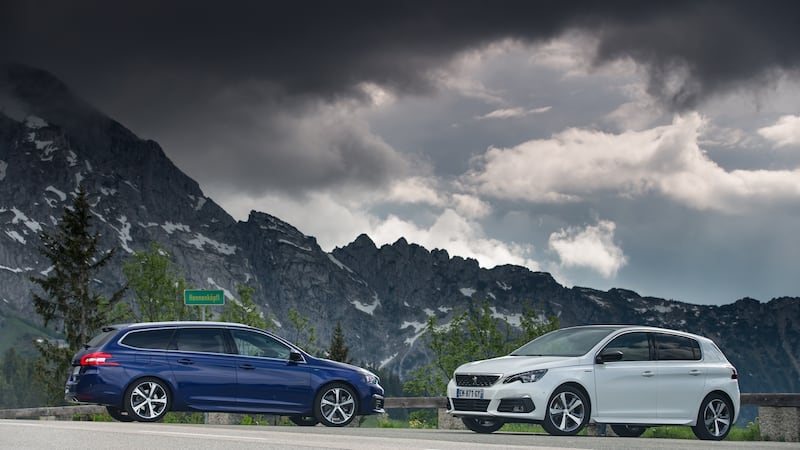While SUV crossovers are the fashionable body style, the classic family car hatchback isn’t quite destined for the scrapyard. Despite the disorderly queues at dealerships for the likes of Peugeot’s 3008 and its ilk, mid-sized hatchbacks remain an Irish new car favourite.
So while Peugeot dealers struggle to meet demand for its award-winning 3008 – car of the year 2017 – the French car brand has given its 308 hatchback a mid-life facelift. As expected there are a few minor exterior changes like a new bonnet and bumpers that have little impact on production cost yet freshen up the exterior. There are some new engine options, again no surprise.
Notably, Peugeot has significantly overhauled the 308’s electronics to keep the car competitive. The 2014 car of the year can now benefit from the availability of the latest galaxy of driving and safety aids in the new 3008/5008.


In Europe the 308 is Peugeot's best-selling car with 760,000 sales since launch.
The front-wheel drive hatchback is presently the fourth best-selling car in France but in Ireland it has failed to draw that level of interest from buyers. Only 6,000 have been sold since the 308's 2007 debut. So far this year a mere 232 have found Irish homes. Yet when you compare the new 308 to the Volkswagen Golf it is surprising how close they are. So why is it not more popular?
Emma Toner of importing firm Gowan Distributors said: "The 308 would be a much bigger seller if there was a saloon version available."
Popular
Saloon variants account for 39 per cent of the sector sales in Ireland and regrettably Peugeot’s saloon in this format – badged the 301 – is only built in left-hand drive and limited to eastern European markets where it is sold as a budget car.
On the upside there is an estate version – the SW – which remains popular on continental Europe with young families.
On the test roads in Germany, the 308 shows little change to what was a good-looking five-door to begin with. The five trim and equipment levels remain the same, topped off with a GTi variant. Peugeot says its customers are buying higher-grade models these days, which is useful for Peugeot's parent firm, the PSA group, which wants to reposition the brand as its more upmarket quasi-premium offering.
Inside the cabin is well laid out, comfortable and free of clutter. The 308’s impressive i-Cockpit dash layout is the star attraction. The i-Cockpit places the speedometer and rev counter close to the base of the windscreen within easy glance. This simple positioning makes viewing information safer and helps the driver keep their eyes on the road ahead. A new 9.7-inch centre touchscreen display allows access to secondary controls such as sat-nav, climate and entertainment systems.
Among the latest safety systems fitted to the car, auto emergency braking with distance alert debuts, active lane departure warning, driver attention alert and automatic headlights are offered on the 308. Speed sign recognition and suggestion offers the driver a prompt to reset the cruise control to the latest limit with a simple double tap of a steering wheel button. The latest Pug is also offered with an autonomous parking function that automatically estimates the size of potential parking spaces available and steers the car in to it.
Park and ride commuters – or those who have to park some distance from their workplace can also opt for Peugeot's funky fold-up electrically-assisted foot scooter. First offered as an option with the new 3008 crossover, it is a doddle to fold up to full size, easy to use – it's a foot scooter after all – and recharges when stowed in the boot.
Peugeot has noted a significant pick-up in the sale of its petrol derivatives in the last 12 months, and on the new 308 there is a low-emissions 130hp PureTech 1.2 engine with a revised six-speed manual gearbox. The lively petrol unit has been given a major revision to reduce exhaust emissions and features an efficient petrol particulate filter. Fuel economy is also improved. On the road, the 1.2 litre performs more like a 1.6-litre and while it is a little noisy when worked hard, is an impressive unit.
The 308 range has the lowest average CO2 emissions in the class. The petrol range averages 95gms of CO2 on official figures, while the diesel range averages out at just 82gms.
Cruised at over 160km/h
From September, a stricter emissions standard that further limits nitrogen oxide (NOx) emissions comes into force. The 308 is the first Peugeot to get the new 130hp 1.5-litre BlueHDi diesel and this four-cylinder engine is a real star attraction. It’s smooth, refined and, on unrestricted German autobahns, comfortably cruised at over 160km/h with power to spare.
Admittedly after an hour or so of test driving on a mix of motorway and back roads, the car’s instrument display flashed an engine warning light and an instruction to stop. The information panel quoted an AdBlue Emission control fault. I was on my way again in a perfectly working replacement in a matter of minutes, but Peugeot was clearly embarrassed by the breakdown.
Later that evening I was told it was down to human error: someone had forgotten to fill the car with the pollution reducing liquid AdBlue additive. Peugeot engineers were clearly embarrassed but failing to fill the AdBlue tank is likely to be a human failing in years to come for all motorists.
I suspect a straw poll of motorists would struggle to garner 10 per cent who actually know about AdBlue at this stage, never mind that it needs to be topped up. Access to the AdBlue reservoir, by the way, is now next to the 308’s new fuel flap.
Overall the new 308 is rather good and in several cases superior to better-selling rivals. The French-assembled new 308 is expected to arrive in Ireland this October. Pricing for Ireland will be announced closer to launch. The current range starts from €19,550.
It’s not going to lure family buyers away from the 3008 crossover. However, it proves that car manufacturers are not prepared to throw in the towel on the family hatchback segment just yet, despite the fascination suburban Ireland has with crossovers.





















